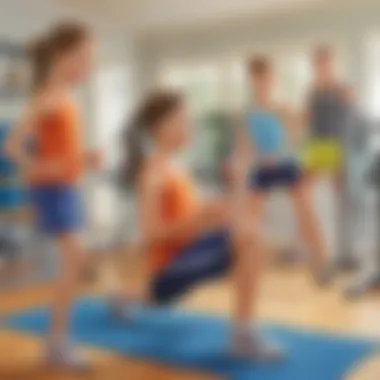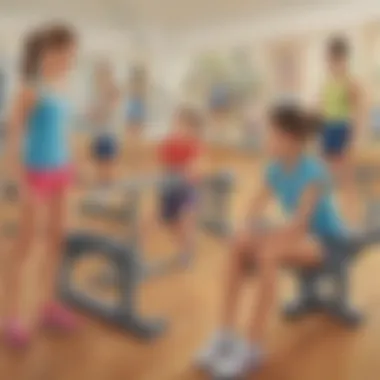Discover Fun Workouts for 10-Year-Olds' Fitness Journey


Intro
Physical fitness plays a crucial role in the development of children. For 10-year-olds, who are often brimming with energy, engaging in structured workouts can promote physical health and a love for movement. At this age, children's bodies are developing rapidly, making it the perfect time to instill healthy habits that can last a lifetime. This article provides insights into effective and age-appropriate workouts tailored for children around this age. Parents, educators, and caregivers can utilize this guide to encourage physical activity and foster a safe environment for our future generations.
Science Fun Facts
When examining physical workouts for this age group, it is vital to understand why they benefit growth and health. Here are some interesting facts about children’s physical activity:
- Studies show that regular exercise can improve mood and reduce feelings of anxiety in children.
- Active children have a better chance of maintaining a healthy weight.
- Exercise aids in developing strong bones and muscles, preventing future health issues.
Regular engagement in physical workouts helps form the essential skills needed for later sports participation and overall well-being.
Age-Appropriate Exercises
Various types of workouts can be fun for 10-year-olds. The key is ensuring these exercises are safe and suitable. Activities like:
- Running and jogging: Building stamina while having a great time outdoors.
- Biking: Offers cardiovascular benefits and improves coordination while exploring the neighborhood.
- Swimming: A low-impact exercise that builds muscle strength and endurance.
Encouraging Participation
To enhance physical activity interest, here are a few practices parents might find useful:
- Involve children in planning workouts or selecting activities. By doing so, they feel a sense of ownership over their routine.
- Make workouts social! Joining friends or family members for physical activities can encourage participation.
- Use technology wisely by using fitness apps or games that promote movement. This can initiate friendly competition.
Adopting these strategies can increase if children enjoy their workouts wholeheartedly. The consensus is simple – enjoyable activities lead to sustained engagement,
Epilogue
Encouraging physical fitness is essential during childhood. It can lay the cornerstone for a healthier future. Ultimately, creating fun and engaging workout routines for 10-year-olds nurtures their interest in physical activity, ensuring they value it throughout their lives. Understanding the science behind exercise further enhances its allure as both enjoyable and necessary.
Understanding Physical Activity Needs
Understanding the physical activity needs of children, primarily around the age of 10, is crucial to their growth and development. Engaging in regular exercise helps promote not only physical strength, but also enhances mental health and social skills. Children are naturally curious and energetic. Therefore, their activities should allow them to explore and strengthen their bodies in a healthy environment. Prioritizing age-appropriate workouts lays the groundwork for lifelong fitness habits.
There are specific considerations regarding physical activity for children. They are still developing both physically and emotionally, meaning their exercise should be enjoyable as well as beneficial. Activities can bolster coordination, balance, and strength, but they shouldn't feel like a chore. Creating a habit of regular activity early in life encourages lasting participation throughout their teenage years and into adulthood.
Recommended Duration of Exercise
The American Heart Association recommends that children, including 10-year-olds, engage in at least 60 minutes of moderate-to-vigorous physical activity daily. For example, this can include activities like running, cycling, or playing soccer. Breaking this time into sessions can alleviate boredom and make it more enjoyable. Parents should aim to include various forms of exercise throughout the week for complete physical development.
Incorporating strength training is also important but should generally occur 2-3 times a week after sufficient training in base aerobic activities has been established. It's suitable for young people to focus on low-weight or even body weight exercises. This prepares their bodies for more advanced exercise as they grow, reducing the risk of injury.
Key Components of Fitness for Children
Physical fitness consists of several key components. For children aged ten, these components should be introduced in a structured yet playful manner. The primary elements entail:
- Cardiovascular Endurance: Activities that boost heart and lung capacity are foundational. Exercises can take the form of games that involve running or cycling.
- Muscular Strength: Engaging in activities that promote strength should not be overlooked. Bodyweight exercises such as push-ups, sit-ups, or climbing on playground equipment serve children well.
- Flexibility: Stretching activities should be a common practice every workout session, allowing muscles to improve with each motion before and after heavier exercises.
- Balance: Coordination games, while fun, significantly aid in developing a child's proprioceptive awareness and stability. Activities that challenge a child's ability to balance are important during this developmental stage.
Emphasizing these components in workouts not only improves physical health but also enhances focus and confidence. Encouraging participation in a breadth of activities fosters a more holistic growth process.
Types of Suitable Workouts
Understanding the types of suitable workouts for 10-year-olds is vital for fostering a lifelong appreciation for physical fitness. At this age, children are typically full of energy and keen to explore. Enriching their exercise experiences is key to attaining both physical improvement and encouraging a healthy mindset.
Regular physical activity can contribute to a child’s growth, coordination, and strength. Each type of workout serves different purposes. Some build endurance while others enhance muscular structure or flexibility.


It's crucial to ensure that workouts are kid-friendly and engaging. This leads to more positive associations with exercise, rather than seeing it solely as a form of discipline or hard work. Below, each relevant workout type is explored in depth.
Aerobic Exercises
Aerobic exercises are crucial for improving cardiovascular health. They help strengthen the heart and lungs. Engaging in these activities increases endurance and promotes healthy respiratory function in growing children.
Examples include:
- Running or jogging
- Cycling
- Jump roping
- Dancing
Aerobic activities should be enjoyable, which motivates children to participate. Group exercises can enhance their social interactions, providing an overall fun atmosphere. Encouraging ten-year-olds to be active can set a foundation for a more active lifestyle as teenagers and adults.
Strength Training
Incorporating strength training into workouts can be highly beneficial, albeit with caution. At this age, exercises can include body weight movements, such as push-ups and sit-ups. Using lightweight objects, like medicine balls, can also lead to notable strength gains. Safety should be at the forefront, ensuring activities focus on guidance over competition.
Strength training helps improve joint integrity and muscle endurance. Importantly, it reduces the regimented feel of 'going to the gym.' Outdoor climbing structures can also effectively contribute to strength training.
Flexibility and Balance Activities
Flexibility training is often overlooked but is essential as children grow. Activities like yoga or simple stretching routines improve flexibility and prevent injuries. Good flexibility contributes to better coordination, allowing for a more dynamic range of motion in various sports and activities.
Balance exercises also enhance physical competence. Activities like standing on one leg or simple coordination games build stability and improve core strength. Overall, incorporating a mix of these workouts in their routine promotes not only fitness but also confidence in their natural abilities.
Remember, the key to engaging 10-year-olds is to make workouts lively and very interactive.
Developing a Workout Routine
Developing a workout routine for 10 year olds is vital in providing structure to physical activities. At this age, children are active and curious, and they benefit greatly from having a focused plan. A routine encourages regular exercise while ensuring safety and enjoyment. Parents and caregivers can help craft a schedule that accommodates their interests and limits boredom.
When creating a workout routine, consider the following elements:
- Variety: Mixing different types of exercises can capture a child's interest. Include aerobic, strength training, and flexibility exercises to keep them engaged.
- Duration: Short and engaging bursts of activity of around 30 minutes may hold attention better than longer sessions.
- Fun and Play: Integrating games into exercise routines helps maintain a child’s eagerness to participate.
Routine development not only promotes physical fitness but also assists in establishing healthy habits early in life, which can lead to lifelong benefits.
Incorporating Fun and Games
Children learn and thrive in playful settings. To maintain interest in physical activity, introducing games is an excellent strategy. Activities like tag, hopscotch, and obstacle courses can turn workouts into enjoyable experiences.
Fun encourages participation, promoting regular exercise patterns. Providing opportunities for children to pick activities boosts their confidence in physical competence. Gamified activity transforms workouts from tasks into adventures, making them something they look forward to rather than dread.
Some ideas for fun exercises include:
- Relay Races: Encourage teamwork.
- Dance Parties: Choose their favorite songs to dance to.
- Outdoor Scavenger Hints: Combine walking with finding items in nature.
Taking part in physical activities that are playful ensures children do not view exercise as a chore.
Sample Weekly Workout Plans
To provide guidance, a sample weekly workout plan offers structure for both children and parents. Below is a simple outline that ensures variety while integrating activity into daily life. Adjustments can be made based on interest and decisions made by the child.
Sample Weekly Workout Plan:
- Monday: Aerobic activity for 30 minutes, like cycling or running.
- Tuesday: Strength training focusing on body weight exercises, play tug-of-war.
- Wednesday: Explore flexibility exercises through yoga or stretching, for 20 minutes.
- Thursday: Fun games like dodgeball for social engagement.
- Friday: Moderate activity, walking the dog or playing hide and seek for 30 minutes.
- Saturday: Family outing, like hiking to combine fitness with family time.
- Sunday: Rest, perhaps discussing fun activities for next week, ensuring a balance.
Breakfast can include engaging discussions on what worked throughout the week. Allowing children's inputs into their workout plan fosters ownership in their physical activity journey. Balance these plans with downtime to prevent burnout, ensuring they enjoy the process.


Safety Considerations
When introducing any type of physical activity to children, safety stands as a fundamental principle. Ensuring a safe environment for workouts not only shields children from injuries, but it also fosters a sense of trust in the activity. Children should feel secure while they learn and participate in physical fitness routines. This extends beyond mere supervision to include proper warming up, cool downs, and analyzing their body's response to exercise.
Proper Warm-Up and Cool Down
Warming up is crucial before engaging in any physical workout. Simple warm-up activities such as gentle stretching, jogging in place, or light cardiovascular exercises prepare the body. Warming up gradually increases the heart rate and enhances blood circulation to the muscles. In particular, children involved in workouts will be less prone to muscle strains and injuries.
A cool down is of equal importance. After exercising, their bodies need to return to a resting state. This period visibly allows the heart rate to decrease and prevents blood from pooling in the limbs. Effective cool down practices include easy stretches or slow walks. Ensuring that children understand these steps helps them to adopt lifelong healthy habits.
Recognizing Signs of Overexertion
Both parents and guardians must be equipped to identify signs of overexertion. Children may not always express discomfort or fatigue verbally. Instead, watch for physical cues such as excessive sweating, flushed face, or changes in their breathing pattern. Mental fatigue can also manifest through irritability or decreased engagement.
Keeping an open dialogue about how they feel before, during, and after workouts can help. Educating children on recognizing their personal limits is equally important. When they learn their boundaries, they can take ownership of their health journey and participate in physical activities with confidence.
Remember: Safety considerations play a crucial role in crafting positive fitness experiences for children.
The Role of Parents and Guardians
Parents and guardians play a crucial role in the physical development of children, especially regarding regular exercise. Children benefit greatly from having supportive figures guiding them in adopting healthy habits. Specifically, parents can offer not just encouragement but also a structured approach to incorporate physical activity into daily life.
Encouraging Regular Participation
To instill a fondness for physical activity in children around the age of ten, parents must actively encourage their engagement in regular workouts. Simple actions can increase a child's willingness to participate.
- Establish a routine: Scheduling exercise sessions at consistent times can help children develop habits.
- Make it enjoyable: Selecting fun activities, like swimming or dancing, will enhance their experience.
- Celebrate achievements: Positive reinforcement each time they complete a workout can build their confidence.
By sharing the joy of exercise, parents present a positive model for children.
Leading by Example
Children often mimic the behaviors of adults around them. By leading an active lifestyle themselves, parents set standards and expectations for what is normal regarding exercise. This kind of role modeling can deeply influence a child's attitude towards physical fitness.
Parents should:
- Engage in sports or fitness classes alongside their children.
- Share their own fitness goals and track progress as a family pastime.
- Demonstrate resilience in pursuing a physically active routine, despite challenges.
These actions affirm that fitness has its place within family life, promoting a culture of health for future generations.
Always remember that children learn from both the words spoken and the actions taken. To inspire a passion for fitness, demonstrate it with personal commitment and visible enthusiasm.
Benefits of Regular Exercise for Year Olds
Regular exercise serves numerous vital needs for ten-year-old children. It goes beyond just being physically active. Not only does it promote better physical health, but it also enhances mental well-being and social skills. Encouraging a well-rounded approach to fitness during these formative years can lay a foundation that impacts both current and future lifestyles positively.
Physical Health Improvements
Engaging in workouts significantly benefits the physical well-being of children. Regular physical activity contributes to healthy growth and development. It strengthens bones and muscles, lending support to overall health. Moreover, it helps in maintaining a reasonable weight and reducing the risk of obesity.
Children who participate in various exercises often show improved cardiovascular health. Their hearts and lungs become more efficient, which promotes endurance. In addition, regular workouts can enhance coordination and balance.
Benefits also extend to the prevention of chronic diseases later in life. Physical activity reduces the risk of conditions like type 2 diabetes and heart diseases. A strong emphasis on fitness at this age can change how children relate to their bodies.
Mental Well-being and Stress Relief
Mental health is an essential aspect of a child’s development. Exercise can act as a natural mood booster. When children engage in physical activities, their brains release endorphins, hormones that help relieve stress and lessen feelings of anxiety.


Furthermore, regular exercise offers children a constructive outlet. As they play and train, they can break away from academic pressures and daily stresses. This healthy distraction can improve overall optimism and enhance self-esteem.
To sum up, being active contributes to better concentration in classroom settings as a result of the next fostered focus and energy management. It also fosters healthier relationships with peers, leading to more enjoyable interactions at school or at play.
Development of Social Skills
Participating in group workouts and sports plays a crucial role in helping kids develop social skills. Working together as a team during exercises helps children learn collaboration and communication. Sports require both cooperation and competition, providing an excellent environment to foster social bonding.
Additionally, it assists in building friendships. Children tend to engage in discussions about their interests and objectives when participation in physical activity. This opens avenues for forming bonds outside exercise activities.
Engaging in workouts with others encourages inclusivity and respect for diversity. Kids learn to appreciate teamwork and understand group dynamics. Overall, exercise offers an educational setting that enriches both personal and relational skills of children.
Regular physical activities influence not just their physical state but they also shape emotional resilience and social interactions which are very important for developing children.
When combined, these benefits create an abiding positive impact. A supportive and enriching environment surrounding these activities may further reinforce the gains made in health, mental well-being, and social adaptability.
Creating a Supportive Environment
Creating a supportive environment is essential when encouraging physical fitness for 10-year-olds. Children thrive in settings that are nurturing and motivating. A thoughtful approach can make a significant difference in their willingness to engage in physical activity. Several key elements contribute to this kind of environment, each combined to enhance enjoyment, safety, and consistent participation.
Utilizing Local Resources
Local resources can greatly enhance the workout experience for children. Parks, sports facilities, and community centers often provide structured programs specifically designed for young people. For instance, many parks have designated areas for different activities. This could include playgrounds, jogging trails, or outdoor sports courts.
Parents and guardians should actively seek out these resources. Joining community classes can expose children to varied physical activities, from soccer to dance. Moreover, these programs frequently encourage social interaction, which is critical for positive reinforcement in exercising.
Local libraries can also be an overlooked resource. They often have books and materials focused on fitness and health tailored for children. Pictures, stories, and activities inspire kids. Engaging with these local resources not only enriches children’s physical engagement but creates memorable shared experiences.
Encouraging Peer Group Activities
Peer activities play a significant role in motivating children toward fitness. Engaging in exercise with friends can transform it from a chore to an enjoyable social event. Many kids are more inclined to participate if their friends are present. Parents can help facilitate this by encouraging group outings.
Examples of peer activities may include:
- Organizing weekend sports games in the neighborhood.
- Arranging group programs like swimming lessons or martial arts.
- Creating dance clubs where children learn popular routines.
It is important to promote inclusivity in these activities. Ensure every child has the opportunity to join, fostering a sense of belonging. Peer support encourages kids to challenge themselves while remaining open to new experiences.
Even if physical activities can seem daunting, the presence of friends often transitions fear into fun.
Fostering social connections while children exercise not only enhances physical activity levels but can significantly impact their mental health, communication skills, and overall well-being. Creating this type of supportive environment allows children to cultivate a love for movement and health that can stay with them for a lifetime.
Epilogue
Recap of Importance of Exercise
Regular exercise is essential for children, especially for ten-year-olds. This age marks a critical time in physical and mental development. Engaging in consistent workouts helps improve physical health, fosters social interaction, and contributes to overall well-being. During activities, children strengthen their muscles and enhance cardiovascular endurance. Positive habits formed now can lead to a lifetime of fitness.
Research shows that active children perform better academically and display higher levels of emotional health. By participating in various sports or structured workouts, kids also discover interests that can last a lifetime.
Heart health, coordination, and strength are all bolstered by exercise. Unique aspects of fitness, such as strength training, enhance their physical abilities without risk of injury if supervised properly. Highlights include:
- Improved physical health
- Better social skills through team sports
- Increased focus in studies
Physical activity – a key pillar that supports the development of lifelong healthy habits.
Final Thoughts for Implementation
Implementing exercise routines for ten-year-olds can feel daunting for parents and caregivers. However, a gradual approach eases this process. Start with fun and engaging activities. In addition to routines, games can significantly encourage participation. Scheduling regular workout times in a fun environment helps promote cooperation among children.
Once a routine is established, it’s necessary to approach physical fitness as a holistic experience. This encourages children to appreciate the benefits of being active. Monitor their interests and adapt activities to evolve with their growing preferences. It is equally critical to set realistic goals to track progress without undue stress.
Consider introducing supporting tools, such as keeping a workout log or discussing progress openly. Finally, always prioritize safety guidelines and instructions to protect children from injury. This thoughtful approach ensures engaging and comprehensive workout experiences as they learn valuable lessons in staying active.







